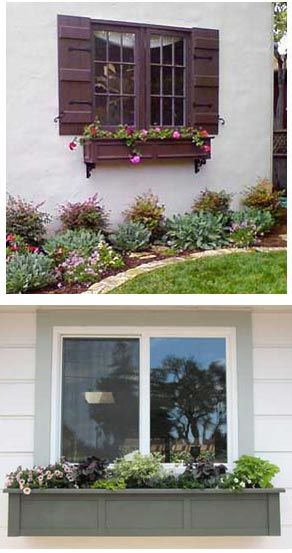Painting PVC Window Boxes and Shutters

Cellular Composite PVC window boxes and shutters are a cut above the rest when it comes to curb appeal installations. Though they may look and feel like wood, there are no wood properties in its construction so they don't have the same maintenance requirements. As a result, moisture is neither retained nor attracted which would otherwise cause peeling or cracking. Our PVC accepts paint willingly so it will last longer than painted wood. Because they don't rot, warp, or crack, this makes customizing them with paint very easy.
Choosing Colors for Your Window Box and Shutters
When you're choosing colors for your window box or shutters, keep in mind the colors of the exterior of your home. We suggest using neutral colors that will match the trim, front door, or siding of your home. For window boxes, choose a color that will highlight the plants that will be planted in the box or will match your shutters, if you have them.
For light paint colors, use an acrylic latex paint with the Light Reflective Value (LRV) of 55 or higher. For dark paint colors, use an acrylic latex paint with a Light Reflective Value (LRV) of 54 or lower. Should you choose to change the color from the bright white we offer, simply follow the instructions below.

Instructions for Painting PVC
1. Read and Follow Directions Thoroughly
Cellular Composite PVC is the material of choice for most of today's window and roof trim. As a result, painting instructions are simple and straight forward. Individual paint manufacturers have different suggestions and we recommend you follow their guidance for the greatest longevity and to maximize the time between having to repaint.
Paint life is normally longer on cellular PVC than wood due to the absence of moisture in the material. Cellular Composite PVC does not require painting for protection or longevity but accepts and holds paint very well.
2. Clean the Surfaces Thoroughly
All PVC surfaces must be clean, dry, and free of any foreign materials such as dirt, oil, grease, or other contaminants that may come from storage, handling, or installation prior to painting. A cotton ball soaked in rubbing alcohol is a good way to remove stubborn blemishes and clean water works well for ordinary smudges.
3. Painting Your Window Box or Shutters
Cellular composite PVC does not need primer. Primers are typically used to seal the paint from absorbing into the material's surface. Since cellular PVC won't accept moistures, an easy and even coat is all that is required. The number of coats is up to you! For window boxes, make sure to leave the inside of the box unpainted where soil and water will be in direct contact. If you feel more comfortable using a primer, the experts at Sherwin-Williams suggest using a multi-purpose primer/sealer and allow up to four hours for it to dry before painting over it.
4. Allow the Paint to Dry Completely
Since our composite PVC does not absorb paint, your paint will take longer to dry than if you were painting wood. Generally paint will be dry to the touch quickly but may take up to 30 days to fully cure. In climates with severe humidity, the time may be longer.
After the paint has had plenty of time to cure, you can install your window boxes and shutters knowing you have a one of a kind curb appeal installation that will be the envy of the neighborhood. Take a quick picture and send it to us at social@hooksandlattice.com. We'd love to see your DIY home improvement project!
